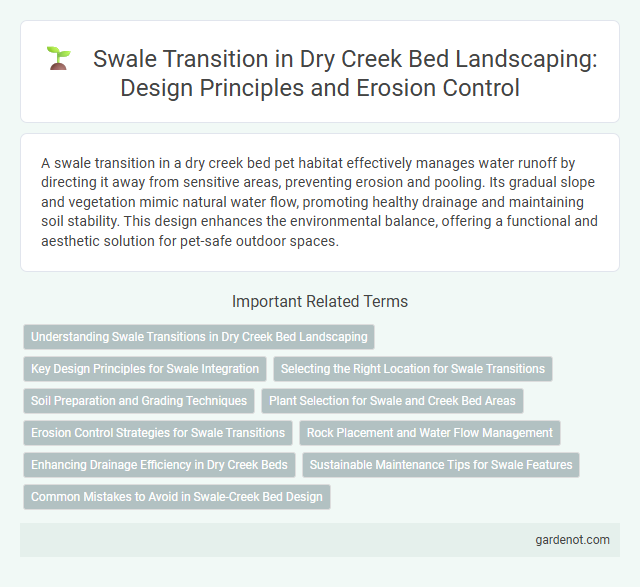A swale transition in a dry creek bed pet habitat effectively manages water runoff by directing it away from sensitive areas, preventing erosion and pooling. Its gradual slope and vegetation mimic natural water flow, promoting healthy drainage and maintaining soil stability. This design enhances the environmental balance, offering a functional and aesthetic solution for pet-safe outdoor spaces.
Understanding Swale Transitions in Dry Creek Bed Landscaping
Swale transitions in dry creek bed landscaping manage water flow by directing runoff safely through changes in terrain elevation. Properly designed swales ensure effective drainage, prevent soil erosion, and support native vegetation growth. Integrating swale transitions maintains the ecological balance and enhances the visual appeal of dry creek bed features.
Key Design Principles for Swale Integration
Swale integration into a dry creek bed requires careful consideration of hydrological flow patterns and soil permeability to enhance water infiltration and reduce surface runoff. Key design principles include maintaining a gentle slope to facilitate gradual water movement, incorporating native vegetation for erosion control and sediment capture, and ensuring proper sizing to accommodate peak stormwater volumes. Effective swale design promotes groundwater recharge while minimizing flood risks and improving the ecological function of the dry creek bed system.
Selecting the Right Location for Swale Transitions
Selecting the right location for swale transitions in a dry creek bed requires careful assessment of the site's topography and water flow patterns to ensure efficient drainage and erosion control. Identifying natural low points and gradual slope changes allows for seamless integration of the swale, enhancing water infiltration and reducing runoff velocity. Proper placement maximizes the ecological benefits, promoting sediment capture and supporting native vegetation growth along the dry creek bed.
Soil Preparation and Grading Techniques
Swale transition in dry creek beds requires precise soil preparation and grading techniques to ensure effective water flow and prevent erosion. Proper excavation involves shaping the soil gradient to direct runoff toward designated drainage areas, using compacted, well-drained soil layers to maintain stability. Incorporating organic matter enhances soil structure, facilitates infiltration, and supports vegetation establishment for long-term swale functionality.
Plant Selection for Swale and Creek Bed Areas
Choosing native, drought-tolerant plants such as sedges, rushes, and swamp milkweed enhances swale and creek bed areas by improving water absorption and reducing erosion. Deep-rooted species like switchgrass and blue flag iris stabilize soil, promote groundwater recharge, and provide habitat for local wildlife. Incorporating a diverse mix of moisture-loving perennials and grasses supports the swale's function in stormwater management while maintaining ecological balance.
Erosion Control Strategies for Swale Transitions
Swale transitions require effective erosion control strategies like installing check dams, using erosion control blankets, and planting deep-rooted vegetation to stabilize soil and slow water flow. Proper grading and the incorporation of rock-lined channels help dissipate energy and prevent soil displacement. These measures are critical for maintaining the integrity of dry creek beds and minimizing sediment runoff during storm events.
Rock Placement and Water Flow Management
Rock placement in a dry creek bed swale transition is critical for stabilizing soil and directing water flow efficiently. Strategically sized rocks are positioned to slow runoff velocity, reduce erosion, and facilitate groundwater infiltration. Effective water flow management through this method prevents sediment displacement and ensures a balanced ecosystem within the swale system.
Enhancing Drainage Efficiency in Dry Creek Beds
Swale transition significantly enhances drainage efficiency in dry creek beds by directing stormwater runoff through vegetated channels that slow water flow and promote infiltration. This natural filtration process reduces erosion and sediment build-up, maintaining the creek bed's structural integrity. Implementing swale transitions optimizes water management and supports sustainable landscape design in dry environments.
Sustainable Maintenance Tips for Swale Features
Swale features require regular inspection to ensure proper water flow and prevent sediment buildup that can compromise their efficiency. Incorporating native vegetation with deep root systems stabilizes soil, reduces erosion, and enhances filtration capacity. Implementing seasonal debris removal and controlled mowing preserves the swale's functionality while supporting local biodiversity and water quality.
Common Mistakes to Avoid in Swale-Creek Bed Design
Improper grading and insufficient slope are common mistakes to avoid in swale and dry creek bed design, as they cause poor water flow and erosion. Neglecting to use native plants and appropriate mulch reduces stability and filtration effectiveness. Overlooking adequate outlet protection can lead to downstream flooding and structural damage.
Swale transition Infographic

 gardenot.com
gardenot.com